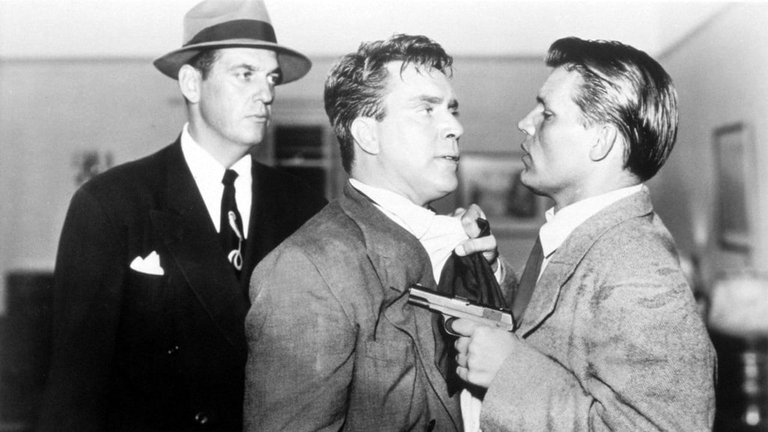Film Review: D.O.A. (1949)

Film noir is, by its definition (“black film” in French), a very dark genre in which very bad things tend to happen to protagonists. However, few things look as dark and depressing as the main premise of D.O.A., a 1949 film directed by Rudolph Maté, which is now considered one of the most famous film noirs and one of the most influential thrillers in the history of Hollywood.
D.O.A. begins with what was arguably the most effective and memorable opening of a Hollywood film at that time. A man (played by Edmond O’Brien) walks through a Los Angeles police station, arrives at the homicide division, introduces himself as Frank Bigelow, and reports a murder that happens to be his own. The plot, told through flashback, begins a day earlier when Bigelow, a hard-working accountant and notary public in Banning, a small town near Palm Beach, decides to spend a little vacation in San Francisco. He needs a release from his monotonous life, and his secretary and lover, Paula (played by Pamela Britton), reluctantly agrees to let him have it. Bigelow is thrilled to enjoy a stay at a hotel, which is apparently filled with many hard-partying people and beautiful women, ultimately leading him to spend an evening in a bar. The next day, he wakes up with something that appears to be more unpleasant than a simple hangover and goes to see a doctor. He receives devastating news that he has apparently ingested a fatal dose of “luminous toxin” that has no antidote and that it will kill him in a matter of days. Bigelow is convinced that someone poisoned him deliberately and decides to find the perpetrator, using the long-distance services of the still unsuspecting Paula. She tells him that a man named Eugene Phillips desperately tried to contact him before his trip. This is the lead Bigelow follows, and when he learns that Phillips has apparently died under suspicious circumstances, he continues the investigation, which involves Phillips’ family and business associates, who are apparently involved in the theft of highly valuable iridium.
D.O.A. has all the proper ingredients of film noir – superb black-and-white cinematography, a fatalistic tone, an antiheroic yet ordinary protagonist who gets into trouble because of his personal flaws, and a femme fatale – but it gives them an unusual spin. The protagonist, superbly played by Edmond O’Brien, is an ordinary man, but with a different kind of “normalcy,” in this case developed by the emerging post-WW2 middle class, to which Bigelow belongs. He gets into trouble because he can’t resist the temptations of the big city with its exotic nightlife and loose women, which are so different from the monotony of small-town life. The femme fatale in this particular case isn’t a brunette seductress but a blonde, played by the charming Pamela Britton (who would become a big star in the popular TV series My Favorite Martian in the 1960s), embodying everything good and proper that mid-20th-century American society expected of women. It is Paula’s insistence that Bigelow does the right thing, implying marriage, that makes Bigelow test his bachelorhood on a trip that ultimately becomes fatal.
The script by Russell Rouse and Clarence Greene has an original idea, and because of it, D.O.A. is sometimes described as Hollywood’s first “high concept” film, made decades before such practice was fashionable. However, it seems that Rouse and Greene exhausted much of their creativity with that idea, and the plot appears underwhelming compared to the strong opening. The film meanders in tone, with the first third resembling a comedy, as Bigelow acts like a “fish out of water” in the big city, while the second begins to unravel a rather unimpressive mystery in which iridium serves as a Hitchcockian MacGuffin. The final scenes feature more suspense, much of it provided by Neville Brand as the sadistic henchman Chester, culminating in a showdown that takes place in the Bradbury Building, an iconic location later immortalised by a similar scene in Blade Runner. It is Rudolph Maté, a cinematographer known for his work with Carl Theodor Dreyer and in some classics of 1940s Hollywood, who keeps these different parts together, making smooth transitions and maintaining a quick tempo with his superb direction. The black-and-white cinematography by Ernest Laszlo works well, particularly in studio scenes and in San Francisco locations, including guerrilla-style scenes when the protagonist aimlessly runs through the streets. Maté also enjoys the services of veteran composer Dimitri Tiomkin, whose effective score is complemented by a jazz band in a scene that takes place in a nightclub, depicting the emerging Beat subculture built around that music. With proper elements of humour, melodrama, social commentary, and action, D.O.A. represents a very good example of film noir and a film that deserves its status as a classic. As such, and with such an intriguing premise, it was bound to have many indirect or direct remakes, the most notable being the 1988 version starring Dennis Quaid.
RATING: 8/10 (+++)
Blog in Croatian https://draxblog.com
Blog in English https://draxreview.wordpress.com/
InLeo blog https://inleo.io/@drax.leo
InLeo: https://inleo.io/signup?referral=drax.leo
Unstoppable Domains: https://unstoppabledomains.com/?ref=3fc23fc42c1b417
Hiveonboard: https://hiveonboard.com?ref=drax y
Bitcoin Lightning HIVE donations: https://v4v.app/v1/lnurlp/qrcode/drax
Rising Star game: https://www.risingstargame.com?referrer=drax
1Inch: https://1inch.exchange/#/r/0x83823d8CCB74F828148258BB4457642124b1328e
BTC donations: 1EWxiMiP6iiG9rger3NuUSd6HByaxQWafG
ETH donations: 0xB305F144323b99e6f8b1d66f5D7DE78B498C32A7
Posted using CineTV